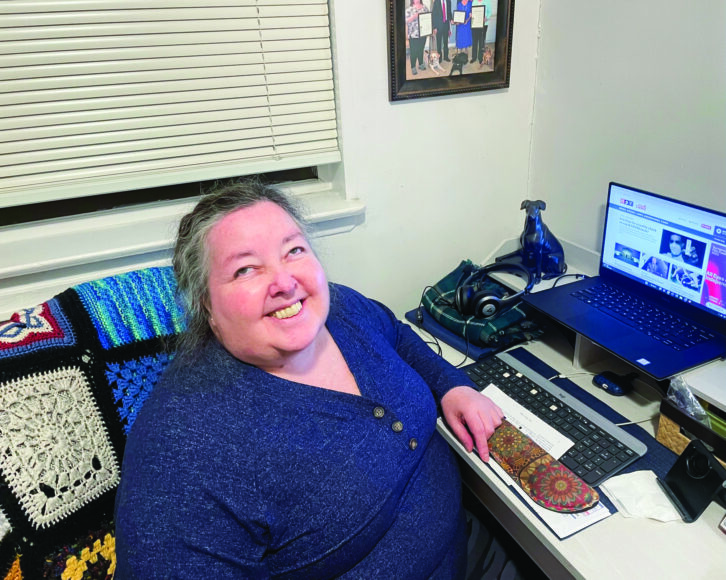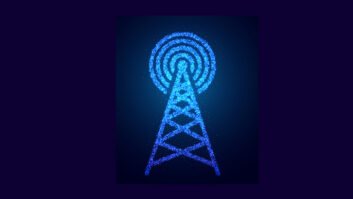
In the 1920s, newspaper articles called radio a godsend for the blind. It was both educational and entertaining, and it would help them to feel less isolated.
Today, many people with visual impairment live independent lives and enter a variety of occupations, including broadcasting. Thanks to technologies like screen-reading software, most internet websites are accessible. And a growing number of movies and television programs now have audio descriptions.
So what role does radio play in a world in which blind people have so many information and entertainment choices?
“It all comes down to how you define radio,” says Rick Morin, manager of ACB Media, operated by the American Council of the Blind.
Media consumption patterns among the blind reflect those of the population at large. Morin grew up in Springfield, Mass., in the 1960s, and he loved AM top 40, but he is well aware that listening habits have changed.
“Most blind people I know still listen to some [terrestrial] radio, but … there has been an explosion of electronic content that is available on internet radio and podcasts.”
Peter Altschul is an author and motivational speaker who co-hosts a weekly podcast. He grew up in New York, where he listened to AM top 40 deejays like Dan Ingram and sports announcers like Phil Rizzuto and John Sterling.
“The announcers back then made you feel as if you were there. They gave vivid descriptions,” he said.
These days Altschul lives in Columbia, Mo., and still listens to sports radio, which “is as good as what I listened to growing up.” But he misses the live and local stations and the personality deejays he heard as a kid. He gets most of his music from satellite radio.
“SiriusXM has much more variety and fewer commercials,” and best of all, “there are no political ads.”
“The same songs over and over”
Doug Hunsinger too finds his local radio stations more political and less informative than he would like.
The retired government employee, 69, lives in Pittsburgh but grew up in Virginia. His memories include personality deejays and listening to distant stations at night, when the local daytimers went off the air.
Radio was almost like an obsession in those days. “I carried my transistor everywhere.” He recalls telephoning the local deejays to make requests. He finds local AM dominated by conservative talk. “There isn’t as much local news on radio as there used to be. There’s more news on TV than on radio.” As for FM, he finds that most music stations “play the same songs over and over.”
Like Altschul, he gets his music from SiriusXM, and he sometimes listens to internet radio.
The change of a beloved radio format can also push a loyal listener away.
Ann Chiappetta, 58, is a retired therapist who grew up in New Rochelle, N.Y. “In the 1970s and 1980s, it seemed the radio was always on. I listened to FM because AM was for old folks.” Her favorite was a Long Island album rocker that played many songs no other stations did. She listened for years, but then one day circa 2004, the format she loved was gone.
“When it went off the air, it was a great loss. After that, my connection to radio began to change.”

She still listens to radio, but not as frequently as before — “mostly news on NPR, and sometimes sports radio.” But for music, she prefers to choose her own, or she seeks out internet stations. “I use my computer to interact with the world. I have my music on my phone. I’m always plugged in somewhere.”
Another common thread is frustration with a lack of variety on most terrestrial stations.
Walden Hughes lives in Costa Mesa, Calif. “I lost my sight at age 9, and radio became very important in my life.” He liked country music and sports, but he also found talk shows educational.
“The 1970s and 1980s were the golden age of talk radio. There were great debates about issues, and no name-calling. I could learn from it.”

Today, the 56-year-old listens to C-SPAN Radio, but he finds most current talk shows too argumentative. Plus, “There are too many nationally syndicated hosts, and not enough who are local.”
Hughes also loves “golden age” radio, especially radio drama, so he decided to do something about it: He operates a popular internet station, Yesterday USA, which features old-time radio shows.
His friend Larry Gassman, 68, lives in Fullerton, Calif. Gassman and his twin brother John co-hosted a weekly OTR show on a Pasadena station for several decades, and are still streaming on the internet.
Gassman recalls that when he was growing up, there were many live and local stations, and “the announcers talked to you. Even the talk show hosts were more laid back. I used to be able to listen to radio for hours at a time.” Now, local radio sounds generic. “A lot of it is on satellite. And there’s a lot of voice-tracking. As good as [the announcers] might sound, I can always tell that they’re not [local].”

Ken Meyer is another former terrestrial broadcaster who now utilizes streaming audio. Meyer spent 14 years at WBZ Radio in Boston, where he became well-known for booking guests for popular talk show host Larry Glick.
Growing up in Rochester, N.Y., Meyer, 76, remembers that “I always loved radio, from the time I was a kid. I used to pretend to be a deejay.” And like Doug Hunsinger, he enjoyed tuning in late at night.
“There used to be something magical about picking up distant stations.” In fact, WBZ could be heard in 38 states, and other clear-channel stations came in loud and clear too.
Now, thanks to streaming, he can listen live online to stations from anywhere. There might be less romance in it, but there’s no static. And there’s another benefit: the ability to reach a national audience. Meyer hosts a podcast for WBCA, Boston Community Radio, a low-power FM station, and his podcasts are accessible via the internet.
Many forms of radio
To younger respondents, terrestrial radio is just another outdated technology.
Steph Brown, 22, a student of the author at Lesley University in Cambridge, Mass., recalls, “I used to listen to the radio in my parents’ car” and nowhere else.
“As I was growing up, I noticed that only older blind people still thought radio was important. People my age had stopped relying on it. In fact, I don’t know many people my age who still listen to radio.”
Brown enjoys podcasts but terrestrial radio is not an option. “I don’t like the commercials and the repetition. I like to choose my own songs.”
Jessica Hodges, a 26-year-old from St. Paul, Minn., also listened to radio in her parents’ car. She developed a love for classical music, but she says she can’t find enough variety locally because “the stations that play it are all [affiliates] of Minnesota Public Radio,” resulting in a certain sameness on the air.
She no longer listens much. “I can get what I want from streaming services,” she says, and enjoys being able to curate her own playlists.
Reading services
Despite these trends and challenges, radio remains important for many in the visually impaired community, especially older ones. Some rely on reading services to keep in touch.
“Most of our listeners are seniors who have experienced a vision loss later in life,” said Maryfrances Evans, president of the board of the International Association of Audio Information Services. She also is executive director of IRIS, the Iowa Radio Reading Information Service for the Blind.
“Though technology offers all kinds of delivery choices, our listeners grew up on radio. They are a ‘don’t fix it if it ain’t broken’ generation, and radio continues to serve them well. It is familiar, it can bring them the hometown high school football game or the national news. Radio does not require a password, monthly fee or download – just turn the knob and it is there.”
One of the most dramatic consequences of vision loss, she said, is social isolation. “Radio, especially smaller local stations, keeps listeners connected to the social fabric of their community.”
For the reading services, radio — including FM subcarriers — remains critical distribution infrastructure.
“Many of our stations, including right here in Iowa, broadcast on the SCA side of these stations,” Evans said.
“Here in Iowa, Iowa Public Radio considers IRIS an extension of their mission. Most of our reading services now have internet delivery options, but those custom SCA radios remain the dominant delivery solution for our listeners. They know how to use a radio. They don’t have to pay for internet service, if it is even available in their rural area.”
Multimedia
As Rick Morin of ACB Media reminds us, all of this just proves the point that “radio” can mean many things, and that blind people are using it in different ways.
ACB Media exemplifies this evolving definition. Until April 2022, it was known as ACB Radio. The name was changed to reflect the availability of 10 live internet audio streams, which offer various kinds of content.
“All of our programs are by, for and about blind people.” Those programs include talk shows that focus on issues affecting the blind community, but there is also a channel that features music by blind artists.
These days, the media landscape is dramatically more competitive than in the past. While OTA radio is no longer the dominant mass medium, radio and audio in all of their forms are a valuable resource, one that many blind people continue to utilize as listeners, content creators or both.







